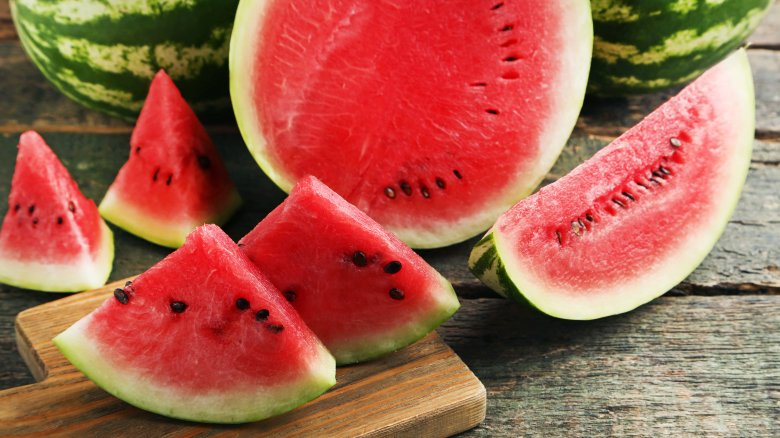How To Tell If A Watermelon Is Good
What do you do when you're faced with the task of choosing a good watermelon? If you just close your eyes, pick blindly, and hope for the best, chances are you've cut into your fair share of flavorless and unripe, or mushy and mealy fruit. And when you've got a craving for a slice of sweet watermelon, that's a huge disappointment, not to mention a huge waste of money. But learning how to choose watermelon is actually really simple, and once you know what to look for, you'll never suffer the disappointment of a subpar melon again.
The Watermelon Board — who should know a thing or two about the topic — says there are just three easy steps to choosing a good watermelon. All you've got to do is look, lift, and turn.
First things first, look at the watermelon to make sure that it's free of bruises, dents, or cuts. It should be firm, not mushy. Second, lift that baby up and make sure it feels heavy for its size. If you're comparing two similarly sized watermelons, the heavier one will be the riper one. The heft also indicates that the watermelon is fresh, because as the fruit ages it loses water, and this all but guarantees dry, mealy flesh. Third, turn that melon around until you see the ground spot. The ground spot is that patch on one side of the melon where it sat in the field ripening in the sun, and a creamy yellow color means that it was picked at its ideal ripeness. If you see a white or light green ground spot — or worse, no ground spot at all — this means that the watermelon was not allowed to ripen on the vine. And since this is not a fruit that will continue ripening on your counter, it's best to avoid those watermelons.
There's one more step to consider when it comes to choosing a good watermelon, and admittedly, this one's a bit more subjective: Give it a thump. The theory goes that a ripe watermelon will sound hollow, while a mushy melon's sound will be muted. Once you master the thump technique, you're officially a watermelon whisperer.
Now that you're confident you can pick the best watermelon, don't be alarmed if you cut into it to find a gaping crack in the flesh. This is called hollow heart disorder, and while it might not look as appetizing, watermelons with hollow heart are perfectly safe to eat, and should be just as tasty as those without the crack. In fact, some even say they're sweeter.
